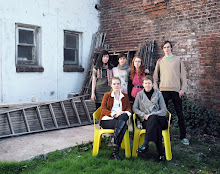illustration of crystal palace by Benjamin Waterhouse Hawkins
march 13 - april 9, white sage will be bringing in new wallpaper, porcelain, and art centered around the theme "new victorian" - below is a quick history lesson about the period [thanks to wikipedia], so no one will be lost when we start conjuring old Ballard ghosts, beefing up our bug collections, and pairing indonesian textiles with danish modern furniture - the victorian era was all about showcasing the multidimential apects of an individual through the display of objects!
opening celebration march 13 6-9pm
The middle of the 19th century saw The Great Exhibition of 1851, the first World's Fair, and showcased the greatest innovations of the century. At its centre was the Crystal Palace, a modular glass and iron structure - the first of its kind. It was condemned by Ruskin as the very model of mechanical dehumanisation in design, but later came to be presented as the prototype of Modern architecture. The emergence of photography, which was showcased at the Great Exhibition, resulted in significant changes in Victorian art with Queen Victoria being the first British Monarch to be photographed. John Everett Millais was influenced by photography (notably in his portrait of Ruskin) as were other Pre-Raphaelite artists. It later became associated with the Impressionistic and Social Realist techniques that would dominate the later years of the period in the work of artists such as Walter Sickert and Frank Holl.
First ever photograph of Queen Victoria (with Bertie), 1844
Popular forms of entertainment varied by social class. Victorian Britain, like the periods before it, was interested in theatre and the arts, and music, drama, and opera were widely attended. There were, however, other forms of entertainment. Gambling at cards in establishments popularly called casinos was wildly popular during the period: so much so that evangelical and reform movements specifically targeted such establishments in their efforts to stop gambling, drinking, and prostitution.
Another form of entertainment involved 'spectacles' where paranormal events, such as hypnotism, communication with the dead (by way of mediumship or channelling), ghost conjuring and the like, were carried out to the delight of crowds and participants. Such activities were more popular at this time than in other periods of recent Western history.
Natural history becomes increasingly an "amateur" activity. Particularly in Britain and the United States, this grew into specialist hobbies such as the study of birds, butterflies, seashells (malacology/conchology), beetles and wildflowers. Amateur collectors and natural history entrepreneurs played an important role in building the large natural history collections of the nineteenth and early twentieth centuries.
Even later communication methods such as cinema, telegraph, telephones, cars and aircraft, would have an impact. Photography was realized in 1839 by Louis Daguerre in France and William Fox Talbot in the UK. By 1900, hand-held cameras were available.
The Victorians were impressed by science and progress, and felt that they could improve society in the same way as they were improving technology. The model town of Saltaire was founded, along with others, as a planned environment with good sanitation and many civic, educational and recreational facilities, although it lacked a pub, which was regarded as a focus of dissent. During the Victorian era, science grew into the discipline it is today. In addition to the increasing professionalism of university science, many Victorian gentlemen devoted their time to the study of natural history. This study of natural history was most powerfully advanced by Charles Darwin and his theory of evolution first published in his book On the Origin of Species in 1859.
Victorian decorative arts refer to the style of decorative arts during the Victorian era. The Victorian era is known for its eclectic revival and interpretation of historic styles and the introduction of cross-cultural influences from the Middle East and Asia in furniture, fittings, and Interior decoration. The Arts and Crafts movement, the aesthetic movement, Anglo-Japanese style, and Art Nouveau style have their beginnings in the late Victorian era.
Interior decoration and interior design of the Victorian era are noted for orderliness and ornamentation. A house from this period was idealistically neatly divided in rooms, with public and private space carefully separated. The Parlor was the most important room in a home and was the showcase for the homeowners; where guests were entertained. A bare room was considered to be in poor taste, so every surface was filled with objects that reflected the owner's interests and aspirations. The dining room was the second-most important room in the house. The sideboard was most often the focal point of the dining room and very ornately decorated.
Wallpaper was often made in elaborate floral patterns with primary colors in the backgrounds, such as red, blue and yellow and overprinted with colors of cream and tan. This was followed by Gothic art inspired papers in earth tones with stylized leaf and floral patterns. William Morris was one of the most influential designers of wallpaper and fabrics during the latter half of the Victorian period. Morris was inspired and used Medieval and Gothic tapestries in his work. Embossed papers were used on ceilings and friezes.







No comments:
Post a Comment